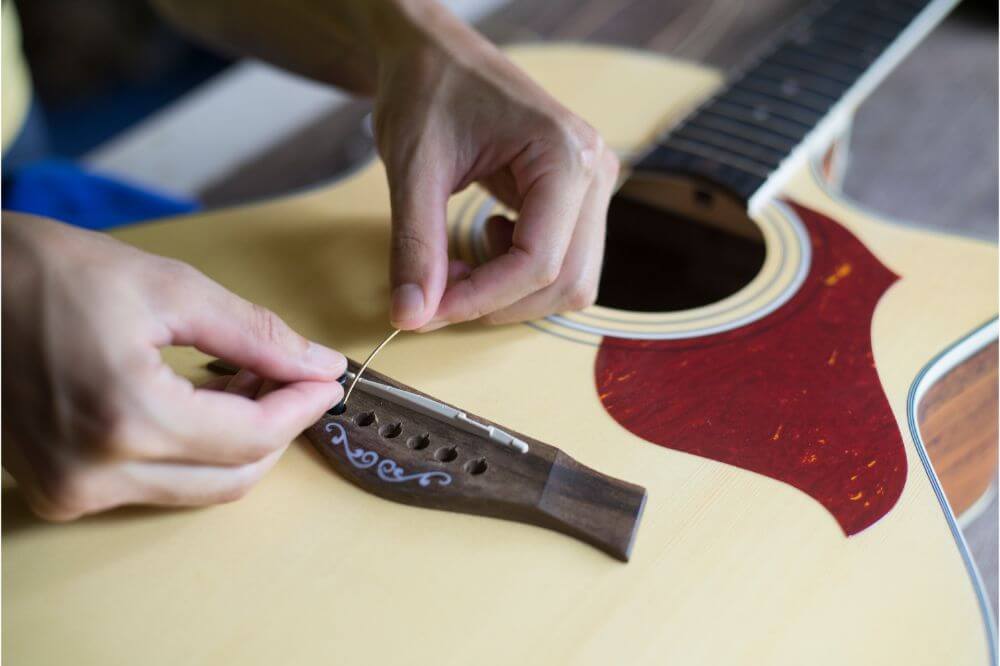Changing guitar strings can be a real pain in the you-know-what, but it is something that needs to be done regularly. How often you change your strings will depend on a number of factors, including how often you play your guitar.
Today we are going to take a look at how often you should be changing your guitar strings, why they need to be changed, and more. Then, we’ll take a look at how to change the strings properly in less than 10 minutes. Let’s get started.
How often should You Change Your Guitar Strings?
There are no hard and fast rules when it comes to how often you should change guitar strings. Some people will insist that they must be changed after a certain amount of time, or even after a certain number of playing hours. This can be good advice, but it isn’t always accurate.
In many cases, guitar players change their strings in order to achieve a specific tone. For instance, some guitar players prefer a tone that is bright and rich, whereas others are more into the sound they get from strings that are worn.
If you like the bright tone, then you will need to change your strings every few weeks, or even every week, depending on how often you play. On the other hand, if you prefer the tone that you get from older strings, you can go a few months between changes. This is simply a matter of preference.
Let’s take a look at some other reasons why guitar strings need to be changed regularly.
String Denting
Common sense dictates that the more you play your guitar, the more often you will need to change the strings. Think about it. Each time you play, you are pressing your fingers onto the strings, and the strings rub against the frets. After a while, this is going to put little dents in the strings. The next time you change your strings, take a look and you will see what we are talking about.
How the Strings Feel
While some guitar players like the way well-worn strings feel, many others prefer the feeling of brand new strings. In fact, very few things feel nicer than the slickness of brand new guitar strings. Your fingers will easily slide over the strings, and they are easier to bend when playing lead riffs. The more you play, the more the strings will degrade and lose this feeling. You may even find that your fingers begin to almost stick to the strings.
Once your strings begin to feel different, it is a good sign that it is time to put a new set on. This is particularly true of coated strings, as the coating will flake off over time. If you are using coated strings, take this as a sign that it is definitely time to change them. Otherwise, you won’t get the benefits of coated strings.
String Breakage
Once guitar strings begin to become worn, there is a good chance that you will experience breakage. This is okay if you are just practicing, but it is a real pain if you break a string while performing and have to change it while you are on stage (which is why so many guitarists tend to have at least two guitars with them for every performance).
If you notice that your strings are becoming worn, don’t wait until it is too late to change them. You may even want to change them as often as once every week or two if you are playing regularly. If you are only playing for your own personal enjoyment at home or at parties, you can go longer between string changes.
What Causes Guitar Strings to Degrade?
As soon as you remove a set of strings from the packaging, those strings are going to begin to degrade. The more you touch them, the more they degrade, due to the dirt and oils on your fingers. The more often you play, the more of this dirt and oil ends up on the strings and gets into the ridges.
The dirt buildup on strings will affect the tone you get from them while playing your guitar. This is because it affects the way the strings vibrate.
A brand new set of strings looks so shiny and nice, but the oils from your fingers will take care of that pretty quickly. You will see this mostly in the areas where you play the most. For instance, if you play a lot of chords on the first three frets, this is where you will see the most discoloration.

How to Give Your Guitar Strings a Longer Life
No matter how carefully you try to preserve your guitar strings, they are going to degrade. But, there are ways you can slow down the degradation process so you don’t have to change the strings quite so often.
First, it is important to clean guitar strings after playing, each and every time you play. This is as simple as wiping the strings with a soft cloth to remove sweat, oil, and dirt. A microfiber cloth is best for this, and something that no guitar player should ever be without.
Thanks to the COVID-19 pandemic, for the past couple of years, we have been told over and over again how important it is to wash our hands regularly. Obviously, this was important long before this virus came into existence, and it is particularly important for guitar players. It is a good idea to get into the habit of washing your hands before playing. This will remove the oils that will end up on the strings.
You may also be interested in using a string cleaner, such as Dunlop’s String Cleaner. String cleaners leave a slight oily coating on the strings, which can help to reduce corrosion. Some guitarists say string cleaners are not effective at all, while others use them regularly.
Changing Electric Guitar Strings
Before you can re-string your guitar, you need to remove the old strings. This is a pretty simple task, and it only takes a few minutes. First, loosen the strings at the tuning pegs, which are located on the head stock. Once they are a bit loose, you can use a pair of wire cutters to snip them.
Place your hand over the strings, right where the neck and body meet. Make the cut about halfway between this point and the bridge. Keep your hand over the strings or lay a towel over them in order to keep them from snapping up and hitting you in the eye. Now, you can remove the strings. Don’t forget to wipe down the neck and fretboard before putting on the new set of strings.
There are a few tools you will need to string your guitar:
- New Strings
- Head stock stand
- String Winder
- Wire Cutters
- Guitar Tuner
The Process
Once you have removed the old strings, open the package of new strings. The ball ends should be color-coded, so even if you are just a beginner, you will know where to place each string. The thickest string (bottom E) will be closest to you, and the thinnest string (top E) will be farthest away. Once you have the strings laid out in the proper order, it is time to put them on the guitar, using the following steps.
- Feed each string through the bridge. Pull the strings so the ball ends fit nicely and aren’t hanging out.
- Run the string through the bridge.
- Make sure the eye of the machine head (tuning peg) is parallel to the nut. Once it is, you can slide the string through the eye. Make sure you do this from the inside. Pull the string tight, leaving about an inch or so of slack for winding.
- Turn the string backwards so it is towards the head stock. Loop it under and fold over the top to lock it into place.
- Now it is time to wind the string. If you have a string winder, this will make the job a lot easier and faster. Make sure the string winds below where you locked it into place, and never let go of the string until it is installed and properly tightened.
- Repeat the same process with each string.
- Use the wire cutters to get rid of any excess string. There should be no more than 1/4” of string left, which can be bent on itself if you don’t want it sticking out.
- If the machine heads are on one side of the head stock, turn them all in the same direction. If there are three heads on each side of the head stock, turn the pegs for the bottom strings towards you, and away from you for the top three strings.
- Using the tuner, tune each of the strings. While doing this, pull up on each string, one at a time, near the 12th fret, and again near the 5th Then, tune the strings again. This will stretch the strings so they are ready to play without coming out of tune.
Conclusion
Changing strings isn’t necessarily the most fun part of being a guitar player, but it is necessary. The more you get into the habit of changing your strings, the easier it will be, and the faster you will be able to do it and get back to playing.




















